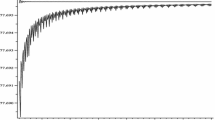Abstract
An American put option can be modelled as a variational inequality. With a penalization approximation to this variational inequality, the convergence rate \(O\big((\Delta x)^{2/3}\big)\) of the Binomial Tree Scheme is obtained in this paper.
Similar content being viewed by others
References
Amin K. and Khanna A. (1994). Convergence of American option values from disete to continuous-time financial models. Math. Financ. 4: 289–304
Black F. and Scholes M. (1973). The price of options and corporate liabilities. J. Polit. Econ. 81: 637–654
Cox J. and Rubinstein M. (1979). Option pricing: a simplified approach. J. Financ. Econ. 7: 229–263
Friedman A. (1975). Parabolic variational inequalities in one space dimension and smoothness of the free boundary. J. Funct. Anal. 18: 151–176
Friedman A. (1982). Variational Principles and Free Boundary Problems. Wiley, New York
Friedman A. (1964). Partial Differential Equations of Parabolic Type. Prentice-Hall, Englewood Cliffs
Jakobsen E.R. (2003). Error bounds for monotone approximation schemes for parabolic hamilton-jacobi-bellman equations. Math Models Methods Appl Sci 13: 613–644
Jiang, L.: Mathematical Modeling and Methods for Option Pricing. World Scientific Publishing Co. Inc., River Edge, NJ (2005)
Jiang L. and Dai M. (2004). Convergence of the explicit difference scheme and the binomial tree method for American options. J. Comp. Math. 22: 371–380
Jiang L. and Dai M. (2004). Convergence of binomial tree methods for European/American options path-depedent options. SIAM J Numer. Anal. 42: 1094–1109
Krylov N.V. (1997). On the Rate of Convergence of Finite-Difference Approximations for Bellman’s Equations. St. Petersb. Math. J. 9: 639–650
Krylov N.V. (2000). On the rate of convergence of finite-difference approximations for Bellman’s equations with variable coefficients. Probab. Theory Relat. Fields 117: 1–16
Lamberton D. and Rogers C. (2000). Optimal stopping and embedding. J. Appl. Probab. 4: 1143–1148
Lamberton D. (2002). Brownian optional stopping and random walks. Appl. Math. Optim. 45: 283–324
Ladyzenskaja, O.A., Solonnikov, V.A., Ural’ceva, N.N.: Linear and Quasilinear Equations of Parabolic Type. Nauka, Moscow (1967); English Trans. (1968)
Lieberman, G.M.: Second Order Parabolic Differential Equations. World Scientific Publishing Co. Inc., River Edge, NJ (1996)
Xu C., Qian X. and Jiang L. (2003). Numerical analysis on binomial tree methods for a jump-diffusion model. J. Com. Appl. Math. 156: 23–45
Wilmott W., Howison S. and Dewyne J. (1995). The Mathematics of Financial Derivatives. Cambridge University Press, London
Author information
Authors and Affiliations
Corresponding author
Rights and permissions
About this article
Cite this article
Liang, J., Hu, B., Jiang, L. et al. On the rate of convergence of the binomial tree scheme for American options. Numer. Math. 107, 333–352 (2007). https://doi.org/10.1007/s00211-007-0091-0
Received:
Revised:
Published:
Issue Date:
DOI: https://doi.org/10.1007/s00211-007-0091-0




